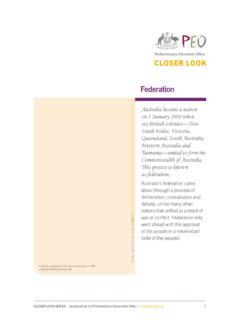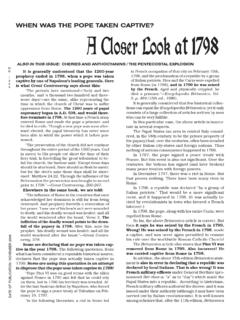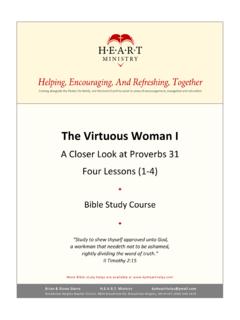Transcription of Closer Look: Governing Australia: three levels of …
1 Closer look SERIES produced by the Parliamentary Education Office | 1 Closer LOOKG overning australia : three levels of law-makingAustralia has three levels of law-making sometimes referred to as three levels of government that work together to provide Australians with the services they needThe three levels are: federal Parliament legislates, or makes laws, for the whole of australia six state and two mainland territory parliaments make laws for their state or territory over 560 local councils make local laws, called by-laws, for their region or level of government has its own responsibilities, although in some cases these responsibilities australia : three levels OF LAW-MAKING Closer look SERIES produced by the Parliamentary Education Office | 2 Australians aged 18 years and over vote to elect representatives to federal, state/territory parliaments and to local councils to make decisions on their behalf.
2 This means Australians have someone to represent them at each level of three level system of Australian Government was an outcome of federation in 1901, when the six British colonies New South Wales, Western australia , Queensland, Victoria, South australia and Tasmania united to form the Commonwealth of australia . Up until the 1850s each colony was run by a non-elected governor appointed by the British 1860 all the colonies, apart from Western australia , had been granted partial self-government by Britain (Western australia became self- Governing in 1890). Each had its own written constitution, parliament and laws, although the British Parliament retained the power to make laws for the colonies and could over-rule laws passed by the colonial parliaments.
3 By the end of the 19th century, many colonists felt a national government was needed to deal with issues such as defence, immigration and federation to happen, it was necessary to find a way to unite the colonies as a nation with a central or national government, while allowing the colonial parliaments to maintain their authority. The Australian Constitution, which sets out the legal framework by which australia is governed, resolved this issue by giving australia a federal system of government. This means power is shared between the federal government and state the Constitution the states kept their own parliaments and most of their existing powers but the federal Parliament was given responsibility for areas that affected the whole nation.
4 State parliaments in turn gave councils the task of looking after the particular needs of their local australia the term parliament refers to an assembly of elected representatives, which has one or two houses, and which makes laws for the country or state/territory. Most parliaments have a head of state the Queen, who is represented by the Governor-General or state Argus, National Library of AustraliaA sketch from Melbourne newspaper, The Argus, urges the colonies to unite, 1898 Governing australia : three levels OF LAW-MAKING Closer look SERIES produced by the Parliamentary Education Office | 3 Sections 51 and 52 of the Constitution describe the law-making powers of the federal ParliamentFederal ParliamentThe Constitution established a Commonwealth, or federal Parliament, which is bicameral.
5 This means it consists of two houses: the Senate and the House of Representatives. Laws can only be passed or changed with the approval of both houses and the Royal Assent of the Governor-General. The 226 members of Parliament 150 in the House of Representatives and 76 in the Senate are responsible for making federal 51 and 52 of the Constitution describe the law-making powers of the federal Parliament. For example section 51 lists 40 areas over which the federal Parliament has legislative (law-making) power. These include: FEDERAL PARLIAMENTC anberraDEFENCEIMMIGRATIONCOPYRIGHTCURREN CY FISHERIES LIGHTHOUSES, LIGHTSHIPS, BEACONS AND BUOYSQUARANTINE BANKRUPTCY AND INSOLVENCY WEIGHTS AND MEASURESCENSUS AND STATISTICSTA X AT I O N FOREIGN POLICY POSTAL AND TELECOMMUNICATIONS SERVICES TRADE AND COMMERCE Under section 51 of the Constitution, state parliaments can refer matters to the federal Parliament.
6 That is, they can ask the federal Parliament to make laws about an issue that is otherwise a state responsibility. Any federal law then made about the issue only applies in the state or states who referred the matter to federal Parliament or who decide to adopt the 52 of the Constitution stops state parliaments from making laws in some areas, including defence and communication. This means the federal Parliament has exclusive power to make laws in these areas. States are also barred from charging customs duties, which guarantees free trade within australia . The creation of a single Australian market was a key reason for federation before 1901 each colony taxed goods imported from the other colonies, which made trade difficult and was considered bad for their lawsGOVERNING australia : three levels OF LAW-MAKING Closer look SERIES produced by the Parliamentary Education Office | 4 State and Territory ParliamentsAustralia has six state parliaments.
7 It also has two territory parliaments known as Legislative Assemblies. These parliaments are located in australia s eight capital cities:Each state, apart from Queensland, has a parliament that consists of two houses. In 1922 Queensland Parliament agreed to abolish its upper house, the Legislative Council, which was made up of non-elected members appointed by the Queensland governor. Queensland Parliament kept the Legislative Assembly, making it unicameral (single-house).The Northern Territory and the Australian Capital Territory parliaments are also unicameral both have one house called the Legislative Assembly. The Australian Capital Territory is unique in australia because its parliament combines the functions of local and state 122 of the Constitution gave federal Parliament the power to make laws for the territories.
8 Until they were granted self-government, the Northern Territory and Australian Capital Territory were administered or managed by the federal government. Federal Parliament gave the territories self-government by passing the Northern Territory (Self-Government) Act 1978 and the Australian Capital Territory (Self-Government) Act 1988 OTHER TERRITORIEST here are eight Australian territories in addition to the Australian Capital Territory (ACT) and Northern Territory (NT): Ashmore and Cartier Islands Australian Antarctic Territory Christmas Island Cocos (Keeling) Islands Coral Sea Islands Jervis Bay Territory Norfolk Island Territory of Heard Island and McDonald territories are governed according to Commonwealth law and the laws of a state, the ACT or NT.
9 Most have an appointed OF STATE/TERRITORY PALIAMENTSGOVERNING australia : three levels OF LAW-MAKING Closer look SERIES produced by the Parliamentary Education Office | 5 State and territory parliaments make laws that are enforced within their state or territory. By defining federal powers, the Australian Constitution reserved or left most other law-making powers to the states. As a rule, if it is not listed in sections 51 and 52 of the Constitution, it is an area of state responsibility. State laws relate to matters that are primarily of state interest such as: On some matters the federal Parliament and the state parliaments may make laws about the same things, for example, roads and health.
10 However, section 109 of the Australian Constitution states that if the federal Parliament and a state parliament pass conflicting laws on the same subject, then the federal law overrides the state law, or the part of the state law that is inconsistent with 122 of the Constitution allows the Parliament to override a territory law at any time. The federal Parliament has only used its power under section 122 on a few occasions and only in cases where the territory law has created much debate or controversy within the Australian until 2011 the self-government Acts covering the Northern Territory and the Australian Capital Territory gave federal ministers the right to veto or change territory laws without referring the matter to federal Parliament.









